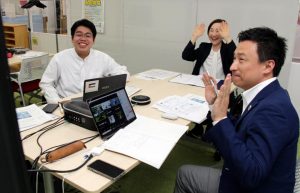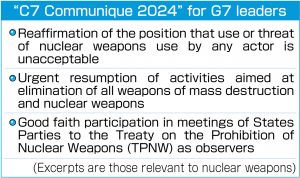One year after G7 Hiroshima Summit, “achievements” in question, Part 3: Citizens foster connections
May 21, 2024
Solidarity formed with world toward nuclear abolition
Policy recommendations, venue for discussions to be set this year as well
by Yumie Kubo, Staff Writer
On May 15, Hiroki Matsubara, 41, secretary-general of the Hiroshima NPO Center, located in the city’s Naka Ward, watched a video being streamed from Italy. He sensed that, “The voices of civil society discussed in Hiroshima one year ago have been soundly passed on to the world.” Mr. Matsubara was one of the people who supported the effort to craft policy recommendations by citizens in line with the summit meeting of the G7 (Group of Seven industrialized nations) held in Hiroshima.
The video Mr. Matsubara watched was livestreamed from the venue of the C7 (Civil 7) Summit, an international conference that gathers civic organizations from around the world. The summit was held in time for the G7 Summit, to be held in June in Italy. Yuta Takahashi, 23, a resident of Yokohama originally from Fukuyama City in Hiroshima Prefecture who serves as co-chair of Kakuwaka Hiroshima, a group composed of young people in Hiroshima actively learning about nuclear policies as voters, was on site at the meeting. Mr. Takahashi reported that he had engaged in discussions regarding the damage wrought by the atomic bombing of Hiroshima and about the elimination of nuclear weapons with representatives of NGOs and young people from the different countries.
NGOs from each nation will once again cooperate with each other to submit policy recommendations to G7 leaders aimed at the elimination of nuclear weapons from the perspective of civil society. Following the policy recommendations made last year, this will mark the second time for representatives of civil society around the world to provide policy recommendations to G7 leaders.
Mr. Takahashi, who was involved in developing last year’s recommendations, said, “It was significant for us to earn a place to hold discussions in Hiroshima and online with people around the world.” The C7 Summit fosters debate on a variety of challenges in addition to nuclear abolition such as climate change and global health.
Since last year, Mr. Takahashi said he has had more opportunities to interact with organizations working in such fields as the environment and humanitarian aid and has received the feedback that “the elimination of nuclear weapons is also important for our activities.” He perceives that reaction as “proof of how citizens around the world have become interested in the hopes of A-bomb survivors and issues involving nuclear weapons.”
A change has also come over the A-bombed Hiroshima. In the spring of last year, in conjunction with the G7 Summit, civic organizations in and outside Hiroshima Prefecture held an event titled “Everyone’s Civil Summit” at the International Conference Center Hiroshima, in the city’s Naka Ward, and other venues. Citizens raised funds for the event themselves and performed work involving the summit venue. More than 700 participants from over 10 nations engaged in spirited discussions. Recommendations, based on the debates that took place, were submitted to the governments.
Tomoko Watanabe, 70, co-chair of that summit event’s working committee and executive director of ANT-Hiroshima, an NPO based in the city’s Naka Ward, emphasized, “Even while in Hiroshima, it’s possible for us to consider global issues and communicate our message to the world. We will continue to create venues where citizens can think along those lines.”
Ms. Watanabe will cooperate with Mr. Matsubara from the NPO Center, her colleague at last year’s event, to hold an event akin to “Everyone’s Civil Summit” later this year in the fall. The theme of the event is said to be “Peace and City Development.” By expanding the circle of their activities to include private companies, the planners hope to create a venue where issues such as city development and the environment can be discussed from broad perspectives.
“Through the civil summit last year, many new connections were created among citizens. We want to continue nurturing that momentum,” said Mr. Matsubara with passion.
Connecting citizens, considering social issues, and raising voices. The seeds for that process also continue to be sown in Hiroshima.
(Originally published on May 21, 2024)









